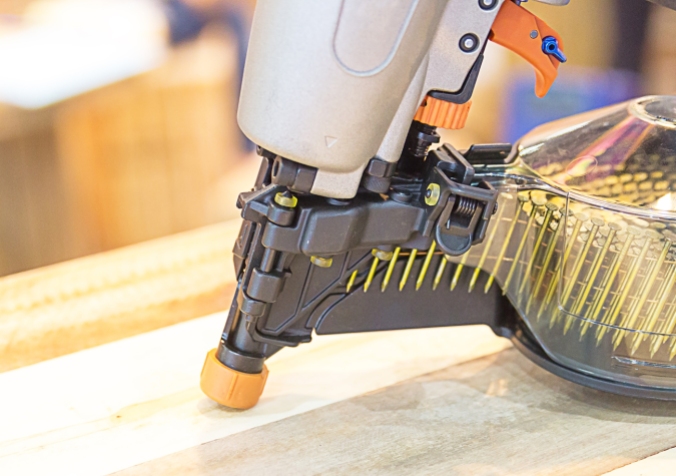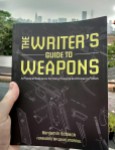On Writing Fiction: How To Use A Nail Gun Like A Firearm
I’m very excited about my new guest, Benjamin Sobieck, author of Writer’s Guide to Weapons.
Take it away, Ben!
On Writing Fiction: How To Use A Nail Gun Like A Firearm

Disclaimer: Your vision will thank you not to try this at home.
Sue Coletta’s 50 60 Ways to Murder Your Fictional Characters is full of terrific prompts to do just that (download it here). Some venture off the beaten path (bamboo plants!) while others take a trip into the garage for inspiration. Entry #57 caught my eye, and I wanted to explore it a little further. Here it is:
57. Nail gun: Easy to use. Easy to carry. Effective if your killer is a good shot. Best to aim for the throat, abdomen, kidneys, etc.
That got me thinking. How does a nail gun compare to a “regular” gun? Could one be used to effectively shoot another fictional character?
Considerations for Characters Using Nail Guns as Weapons in Fiction
Just like firearms, nail guns aren’t all created in the same way. Along with their ammunition (nails), nail guns are designed for different purposes. That means there are different types that use a variety of methods to drive the nail home.
Briefly, nail guns that require a lot of force or extended use are fed by a separate air compressor, which means the character using it can’t wander far. This pneumatic set up is the most popular kind of nail gun, but not the only one. Lighter tasks can be accomplished without an air compressor, using electromagnets or internal combustion, giving the character free rein.
In any case, identify the type of nail gun first. It’ll determine the rest.
Next comes the weight. Nail guns are heavy. How long will the nail gun be in use? Can the character actually lift the nail gun long enough to use it effectively? These things don’t come with sights, so it’s unlikely anything under a few shots will get the job done, even for experienced characters.
The final consideration is the safety. Nail guns come with a sliding safety that must be pressed or held back for it to function. If the nail gun is being fired over a distance, that means the character must use two hands: one to hold the safety back and one to fire. One-handed shots are out.
[tweetthis twitter_handles=”@SueColetta1″]How to use a nail gun like a firearm.[/tweetthis]
How Nail Guns Compare to Firearms
In order to put things into context, I’m going to make some generalizations. I realize nail guns come in a variety of set ups that impact their performance, and some readers might disagree with my conclusions. That’s fine. I’m only looking to do a base comparison.
The first step is to identify how hard a fired nail hits a target over a distance. In the firearms world, this is referred to generally (and debatably) as “stopping power” and is expressed in foot-pounds. The higher the foot-pounds, the greater the “stopping power,” since more energy is transferred into the target from the projectile.
The question then is, how much stopping power does a nail fired over a distance from a nail gun carry, and how does that compare to a projectile from a firearm?
Fortunately, there’s an easy way to calculate foot-pounds (mass x velocity squared x .5). All you need is the mass of the projectile and the velocity at which it travels. That means I need a calculator, a chronograph, a scale and a nail gun. Any takers out there? No? Well, that’s what Youtube is for:
Feel free to watch the entire video, but there are only a few pieces of information to cull:
- The pneumatic nail gun recorded the fastest velocity with 2 3/8-inch nails, at 134 feet per second.
- The velocity decreased with each consecutive shot as the pneumatic nail gun recharged, meaning stopping power would also decrease. The first shot in a series is therefore the most powerful.
- The guy cites 50 yards as the maximum distance the nail traveled.
- At only a few feet away, nails bounced off cardboard (spoiler alert).
- “I don’t think the nail gun is a very good self-defense tool,” the guy says. (spoiler alert again, I need to stop doing that)
Let’s assume the character uses 2 3/8-inch nails that travel 134 feet per second. The next step is to find out how much one nail weighs. Although materials carry different weights, I found these stainless steel 2 3/8-inch nails over at, appropriately enough, Nail Gun Depot. A pack of 1,000 nails weighs eight pounds. That means one nail weighs roughly 3.6 grams.
Now it’s as easy as plugging in 134 feet per second and 3.6 grams into this energy calculator. The result is (drumroll, please)…
2.227 foot-pounds.
How Does 2.227 Foot-Pounds Compare to a Bullet?
What does this 2.227 figure mean? Is that more or less than a bullet?
There’s no such thing as an “average bullet,” but I’ll go ahead and choose a .22 caliber for comparison, which is small yet still popular with handguns. I checked the ballistics tables in my copy of the Gun Digest 2015 (highly recommended, by the way) and conservatively I’m seeing around 100 foot-pounds on average for low-velocity .22’s at the muzzle (or moment that it’s fired). That halves when the bullet is out at 100 yards, or twice the quoted distance of the nail in the video. (Keep in mind the .22 is the primo caliber for squirrels, rabbits and other small game.)
In short, you could say a nail fired from a nail gun carries 1/50 of the power of a .22 caliber bullet fired from a handgun. That fraction only grows weaker the farther out the nail gets. At 50 yards, I imagine it’s like getting hit by a handful of grass.
The Verdict
Although they should still be used with caution and respect, nail guns are no substitute for a proper firearm. If a character really wants to wreck someone’s day with one, get up close and personal. Treat the recipient like a piece of wood.
That’s not to discount the nail gun’s use as a deterrent. Would I want to be shot by one? Nope. I’d book it out of there. Maybe that’s a better purpose for fiction.
If you still want to go down this route, consider it’ll be hard to be accurate. Nail guns aren’t precision “reach out and touch someone” tools. They fall more into the “spray and pray” category. As Coletta points out in her tip, aim for the most vulnerable areas on a character. Even at only 2.227 foot-pounds of energy, a nail to the eye will leave a mark.
About the Author
Benjamin Sobieck is the author of The Writer’s Guide to Weapons: A Practical Reference for Using Firearms and Knives in Fiction (Writer’s Digest Books), as well as a pile of thriller novels and short stories. His favorite sandwich is the reuben. Visit his website for more posts like this one at CrimeFictionBook.com.







19 Comments
US Patriot Armory
Nice idea for a crime novel! Don’t forget that even if it’s hard to shoot someone at a distance, nail guns are still a nice way to hurt someone or yourself accidentally as statistics suggests
Sue Coletta
So true!
Mubarik
This new for me, I just see and found two new thing about Nial Guns and Firearms. Both are new for me and when i reading, I enjoyed it. Thanks 🙂
Wilson Smith
Thanks for the great info on Nail Gun Sue. I learned a lot about using a Nail Gun in this post.
Sue Coletta
You betcha, Wilson. 😉
Gary Fretwell
good post and food for thought. I’ve never done the research, but was very interested to see the results! If there was nothing else, I’d definitely use it.
Gary Fretwell recently posted…20 Christmas Gift Ideas For Hunters [what they REALLY want]
Sue Coletta
So glad you enjoyed it, Gary. Happy holidays!
Christina
Your discussion of the difference between nail guns and real guns is an interesting one. The ways you continue to use either as a weapon in your fiction will be an interesting thing to read.
Sue Coletta
I agree, Christina. Ben’s calculations were fascinating.
Fred Carter
I’m guessing the velocity is similar to a similar-weight bullet from the beloved belated 17 HM2, which used 17gr .17cal v-max bullets in a necked-down Stinger case: around 2100fps from a rifle bbl.
Interesting. Would sure like to see this combo clocked for velocity.
I would also like to see this tested in a variety of different .22 rimfire firearms. Would it work in a derringer?
Sue Coletta
Gee, I’d like to see that, too, Fred. Hmm…not sure about a derringer. I’m guessing no, but Ben is the firearms expert. Let me see if I can get him to answer your question.
Nancy
Here is so many information about nail gun…
Thanks
http://nailgun.edublogs.org/
Sue Coletta
Thanks, Nancy!
Mae Clair
I still remember the nail gun being used in one of the Lethal Weapon movies…was it 2? I’ve used a smaller version for home remodeling projects and still freak at the thought of the danger it could do. Maybe it isn’t up to the same impact of a slug, but I wouldn’t want to get hit with one, LOL!
As always, wonderful post!
Sue Coletta
Oh, you’re right! I think it was Lethal Weapon 2. Super. So maybe my #57 Way To Kill wasn’t so farfetched. Thanks, Mae!
Craig
You could also clout someone over the head with it. It would be a cool crucifixion tool, and I need to remember that.
Sue Coletta
Ooh. Crucifixion tool. That might come in handy in the manuscript I’m working on now.
Ben Sobieck
Funny you mention that, because tomorrow (Thursday) I’m hosting a crime writer who did just that over at CrimeFictionBook.com. He used to use nail guns as part of his job, and he goes over the best type and set up.
Thanks for checking out the article!
Ben Sobieck recently posted…Can a Nail Gun be Used like a Firearm?
Sue Coletta
Really? I can hardly wait. Thanks for the heads up, Ben!